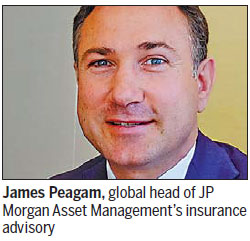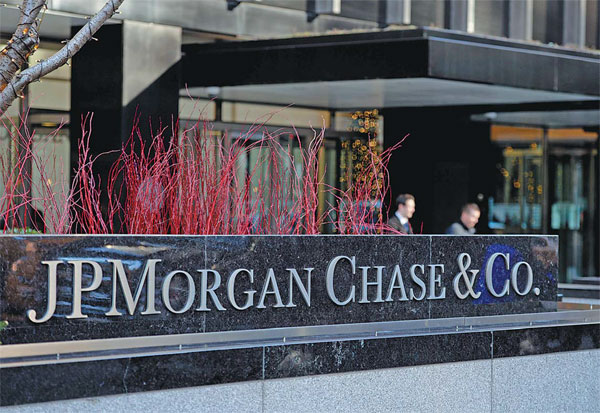European ills put insurers within reach

But Chinese companies eager to buy need to be wary, says expert
China's insurance industry is becoming further integrated into the European economy through Chinese insurance firms' increasing acquisitions in Europe, says James Peagam, global head of JP Morgan Asset Management's insurance advisory.
This trend is emerging against the backdrop of consolidation in the European insurance market, as falling fixed-income yields over the past 30 years are leading to an increasing number of mergers and acquisitions among European insurance firms, Peagam says.
| Chinese households' growing disposable income may help create demand for new insurance products, says James Peagam of JP Morgan Asset Management. Provided to China Daily |
The acquisition of capital-starved European insurers allows Chinese insurers to expand their business overseas and diversify their portfolios, at the same time gaining access to expertise and potentially good returns, he says.
Some notable acquisitions in recent times have included Anbang Insurance's buying the Belgian insurance company Fidea last year and the Dutch insurance company Vivat this year.
Fosun, a Chinese conglomerate, is also diversifying its businesses, expanding into the global insurance market through its acquisition of the Portuguese insurer Fidelidade last year.
Peagam says that in selecting European targets it is important for Chinese insurers to think about the price they pay for the assets, based on the cash-generating ability of the target company, one that would ensure the return on equity is attractive.
"They need to look at the price of the acquisition relative to book value and make a decision as to whether it's sensible to buy," he says.
At the same time, such acquisitions may also have strategic consequences because the targets may have expertise in advanced insurance product design, which can be replicated in China's market.
Chinese households' growing disposable income may also create a demand for new insurance products, he says.
"To a certain extent, the speed of insurance penetration may be tied to the speed of the increase in household wealth. In other cases it may be more a matter of education on the benefits of certain types of insurance products.
"For example, there may be some products that Chinese firms have offered in the past which did not take off, so it would be interesting to research why not, versus similar products in the West which have done well.
"In acquiring Western expertise, they'll get a sense of what we've tried and what's failed and why. A lot of the lessons can be learnt."

Although the trend of Chinese insurance firms' overseas investment started only a few years ago, Peagam says the potential growth of this trend is huge because, subject to certain criteria, Chinese companies are allowed to invest 15 percent of their assets offshore, and at the moment only about 1 percent has been invested.
"This means still a lot of Chinese insurance firms' investments are made in the domestic market, and it may make sense to diversify by investing overseas. Globally we are seeing fewer and fewer insurance firms investing in only their own domestic market, and more investment is going into global fixed income/equity or at least regional equity.
"If Chinese insurance firms invest another 14 percent of their assets into overseas markets, the potential to make an impact is huge."
In Europe, insurance firms are increasingly becoming capital starved due to falling fixed-income yields.
"Such falling yields affect the guarantee that life insurance firms can offer in their products," Peagam says. "It also affects the firms that have made guarantees in the past and need to re-invest now."
Such falling yields are leading to more mergers between European insurers to increase efficiency and creating an incentive for insurers to invest capital in other investment classes.
The harsh macroeconomic conditions that have led to the low valuation of some capital-starved European insurance firms would provide good opportunities for Chinese investment, but the new Chinese owners may need to do a lot of work to improve the targets' efficiency in the post-acquisition integration stage.
"The extended period of low bond yields is putting pressure on companies, in combination with regulatory rules, such as Solvency II. This means the selling price may become more attractive, but the pressures don't go away after the acquisition, although some efficiency may be achieved through diversification."
While acquisitions between European insurers have taken place over the years, it is only in the past year or two that the trend has become obvious, Peagam says. The participation of Chinese insurers in this trend has also made a positive contribution to help to make this market more active.
"I think Chinese insurers' participation is helpful for some companies that would have otherwise had fewer options."
Generally acquisitions of European insurers should produce returns of about 10 percent or more, to justify the level of risks encountered through the acquisitions, he says.
Some Chinese insurers are increasingly buying real estate assets in Europe with less risk and higher returns.
China Life bought 70 percent of an office building along London's Canary Wharf in a $1.35 billion (1.2 billion euros) deal last year, and Ping An Insurance Group bought the Lloyd's of London building for 260 million pounds ($388 million; 345 million euros) in 2013.
"Investing in a building wouldn't involve the same complexities of buying a regulated company, as it is just the purchase of the asset," Peagam says. "After some assessments are made and it is seen to be a good investment, an acquirer may invest in it with a plan to keep it or to improve it and sell it again."
The choice of different classes of assets to invest in depends on the type of capital a Chinese insurer uses to make the investment, he says.
The investment funds can come from the insurer's surplus capital, general account assets, or policy holder money. The returns from the investment will become a return for the sources of the funding, so it is important to match investment with each type of capital's desired levels of risks and returns, he says. This is especially important when using policyholder funds.
Apart from buying insurance firms and real estate, Chinese insurers in the future may also become more comfortable with alternative asset classes, which is a non-traditional investment area that European insurers are increasingly moving into.
"Through acquisitions of European insurers and looking at what's on the balance sheet of these firms, Chinese insurers may come across asset classes they've not thought of before. In addition, they may also gain expertise in investing in these alternative asset classes."
cecily.liu@chinadaily.com.cn
(China Daily European Weekly 05/08/2015 page22)
Today's Top News
- Japan tempting fate if it interferes in the situation of Taiwan Strait
- Stable trade ties benefit China, US
- Experts advocate increasing scope of BRI to include soft power sectors
- New engine powers cargo drone expansion
- China to boost green industry cooperation
- Manufacturing PMI rises in November































